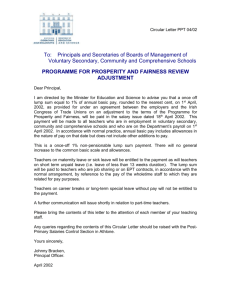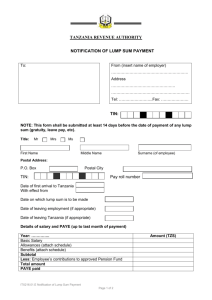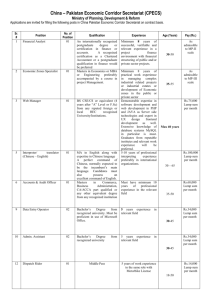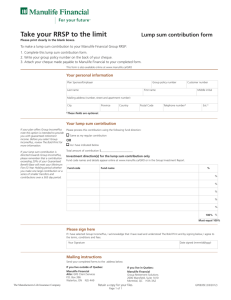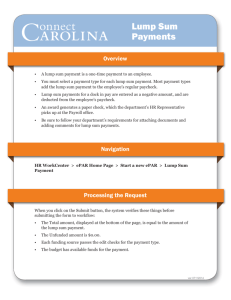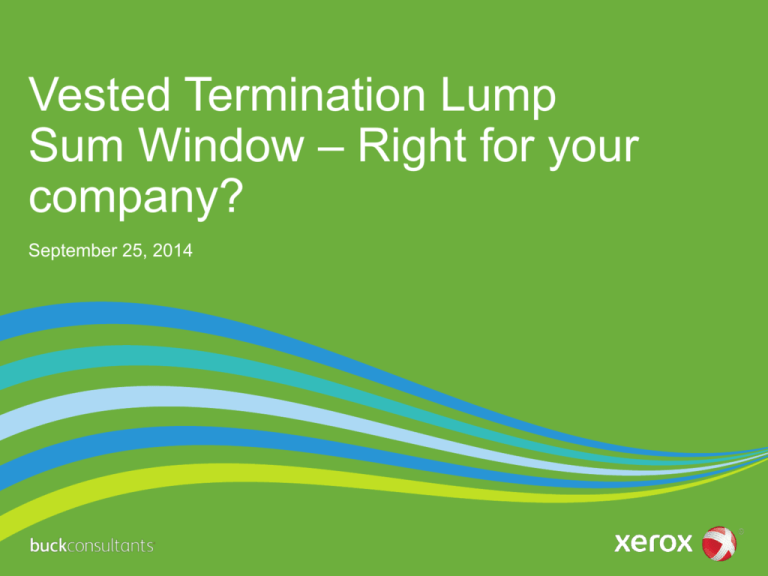
Vested Termination Lump
Sum Window – Right for your
company?
September 25, 2014
Agenda
Background
Considerations
Administration
Communications
Wrap Up
Q&A
2
Speakers
Dean Aloise, ASA, FCA, EA, MAAA
Managing Director
Wealth Practice
Peter J. Borgman
Senior Vice President
Retirement Products and Services
Thomas Mosher, FSA, EA, MAAA
Principal and Consulting Actuary
Wealth Practice
Phil Parker, FCA, EA, MAAA
Principal
Global Technology Delivery and Solutions Practice
3
Purpose of Today’s Webinar
Balanced View
• There are pros and cons
• One size does not fit all
Make Clear the
Financial Benefits
• Can be significant savings
• Example shown later: Spend
$250,000 to save $3.3 million
Highlight the
Potential Risks and
Participant Impact
• May be financial “gotchas” up front
• Participants focus is critical to ensure
this program is a win win for all
4
Administration
Terminated Vested Lump Sum
Window Administration
Capabilities:
Xerox has handled over 40 client
programs in the past 3 years
• Deep experience in administering client
programs
Xerox is currently handling 14
client programs
• Standard processes and tools for
handling target populations ranging
from 150 – 60,000 participants
• Flexible solutions to cover end-to-end
program requirements
• Cross-functional teams configured to
cover design, development, operations,
fulfillment, and call center support
5
Background
Background
Defined benefit plan sponsors have been considering and implementing
de-risking investment strategies in the wake of interest rate and market
turbulence over the last 20 years.
• As plans begin to return to being fully funded again, sponsors may want to consider
permanent risk transfer options, including administrative and design alternatives.
• Very recently, interest in one such option has escalated — offering terminated vested
participants a payout through lump sum windows.
• Terminated vested lump sum (TVLS) windows are very prevalent in 2014 and activity is
expected to remain high into 2015.
• Factors influencing decisions about executing a TVLS window vary by plan and by
company
– Plan structure – open, closed and frozen pension plans
– Cost/benefit to execute window
– Investment management considerations
– Perspectives on paying lump sums
7
Pension Plan De-Risking Approaches
Offer Participants
Lump Sums
• Participants must elect to receive a lump sum
• Settle liability directly with participants for an amount close to
accounting liabilities
Purchase Group
Annuities
• Plan sponsors can elect to transfer pension liability to high
quality insurance carrier
• Premiums can exceed accounting liabilities by 10 - 30%
• U.S. insurers’ capacity raises some concern
Retain Liabilities and
Manage Risk More
Closely
• Plan payments typically expected to continue for 80+ years
• Sponsors have structured long term LDI strategies to
mitigate pension cost and funded level volatility
• Certain demographic risk transfer products may proliferate
8
Alternative Lump Sum Tactics
Limited one-time option or “window”:
• Plan is amended to provide lump sum elections to all or a portion of terminated vesteds:
− Separate from mandatory small cashout “sweeps” or other existing plan provisions for
lump sums
• Lump sum paid only if valid elections made during temporary window period
• Qualified Joint and Survivor Annuity and Qualified Optional Survivor Annuity must also be
offered (with spouse as beneficiary) – if participant is retirement eligible, all optional forms
otherwise available to participant must also be offered
• Providing lump sum election to retirees in pay status requires private letter ruling
Permanent optional form of payment:
• Offer option to all terminating employees or only those who are eligible for retirement
• Restrict eligibility to lump sums below a threshold (e.g. $10,000) to eliminate deemed
smaller annuity benefits
• Permanent feature can add significant cost to annuity contract upon plan termination
9
Considerations
TV Lump Sums Considerations: Summary
Key Advantages
• Permanent liability reduction
• Reduced future administrative costs - most notably plan administration and PBGC premiums that
are scheduled to increase considerably
• Pending change in mortality tables effective in the near future will increase both liabilities and
lump sum costs
• Lump sums are less expensive than purchasing annuities
• Accelerates participant access to retirement assets
Disadvantages
• Potential settlement accounting charges
• In some cases, additional contributions to maintain funding status
• Loss of investable assets (perceived value of asset arbitrage)
• Potentially significant short term administration costs
• Anti-selection among lump sum eligibles
• Participants left to managing their retirement savings on their own
11
Detail on PBGC Premiums
Year
Flat Rate
(previous
law)
New Law
Flat Rate
Variable rate per
$1000 of
underfunding
(previous law)
New Law
Variable Rate
Variable
rate cap
(previous
law)
New Law
Variable
Rate Cap
2013 $42
Same
$9 indexed ($9)
Same
$400
Same
2014 $49
Same
2013 rate indexed +
$4 ($14)
Same
$400
indexed
($412)
Same
2015 $49 indexed
$57
2014 rate indexed +
$5 (at least $19)
2014 rate
indexed + $10
(at least $24)
$400
indexed (at
least $412)
Same
2016 $49 indexed
$64
2015 rate indexed (at
least $19)
2015 rate
indexed + $5
(at least $29)
$400
indexed (at
least $412)
$500
2017 $49 indexed
$64 indexed
2015 rate indexed (at
least $19)
2015 rate
indexed (at
least $29)
$400
indexed (at
least $412)
$500
indexed
12
Status of Mortality Table Changes
The Society of Actuaries (SOA) announced on July 28 that updated mortality
tables will likely be released by October 31, 2014. For accounting purposes,
auditors may recognize mortality studies published by actuarial organizations:
• The new mortality tables released in October will be a factor for consideration for 2014 year end
disclosure (affecting next year’s expense)
• Major accounting firms have issued guidance indicating that they will expect sponsors to:
− Consider the effects of the SOA’s updated mortality tables, and
− Document rationale for best estimate for mortality rates
For funding purposes, benefit restrictions, PBGC premiums, and minimum
lump sums, actuarial organizations’ studies on assumptions have traditionally
been taken into account by the IRS and other government agencies:
• Timing for the adoption of new mortality tables has not been announced
• Given that IRS has promulgated mortality assumptions to use through 2015, updates might not
take place until at least 2016
13
Financial Cost – Alternate Measurements
The value of an individual’s pension liability varies depending on the
purpose of the calculation, primarily due to the interest rate used.
Annuity purchase
Determined by the annuity provider, generally conservative
fixed income rates with margins and expense loads
2.75%
Accounting
Spot fixed income rates as of measurement date
5.00%
PBGC variable
premium
Same basis as for lump sums (e.g., 0-4: 1.25%, 5-19:
4.57%, 20+: 5.60%), no lag period
5.15%
Lump sum
1 month average of fixed income rates, with a lag period
that may be more than a year (e.g., 0-4: 1.40%, 5-19:
4.66%, 20+: 5.62%); basis close to accounting
5.21%
Funding (MAP-21)
25-year average of fixed income rates, subject to “collar”
(0-4: 4.43%, 5-19: 5.62%, 20+: 6.22%)
5.92%
Funding (HATFA)
25-year average of fixed income rates, subject to revised
“collar” (0-4: 4.99%, 5-19: 6.32%, 20+: 6.99%)
6.63%
Risk adjusted
Long term expected return on assets
8.25%
14
Financial Cost – Variance Between Accounting
Methods
ASC (FAS)
IAS
Mark to Market
ASC (FAS)
Expected Return on
Assets
Long term
expectation
Equal to discount
rate
Long term
expectation
Gain/Loss Upon
Remeasurement
P&L amortization Immediate
if outside corridor recognition in
P&L
Immediate
recognition in
P&L
Settlement - One
Time Charge/Credit
If amount settled
is greater than
Service Cost +
Interest Cost
None
15
None
ASC (FAS) Accounting Impact: Settlement
Charge - Example
(in $millions)
Before TVLS
Window
PBO @ 1/1/15
$ (97.0)
Impact of
Window
$
After
Window
13.9
$ (83.1)
(13.2)
89.4
MV @ 1/1/15
102.6
Funded Status @ 1/1/15
$ 5.6
$
0.7
$
6.3
2.6
$
0.0
$
2.6
FY 2015 Expense
Service cost
$
Interest cost
Expected return
Amortization
Total
$
Settlement Charge
4.9
(0.7)
4.2
(8.0)
1.1
(6.9)
2.3
(0.4)
1.9
1.8
--
Assumes unamortized loss position is $36.5 million
16
$
0.0
5.0
$
1.8
5.0
Possible Tactic to Avoid Settlement Charge
Sequential Targeted Lump Sum Windows
No. of
1/1/2015
Participants Lump Sum
Value (in
$millions)
Lump Sum Amount
Cumulative
No. of
Participants
Cumulative
1/1/2015 Lump
Sum Value
< $10,000
407
$0.7
407
$0.7
$10,000 – $24,999
944
$4.5
1,351
$5.2
$25,000 - $49,999
517
$5.1
1,868
$10.3
$50,000 - $74,999
155
$2.7
2,023
$13.0
$75,000 - $99,999
58
$1.5
2,081
$14.5
$100,000 - $249,999
73
$3.1
2,154
$17.6
$250,000+
19
$2.4
2,173
$20.0
2,173
$20.0
Total
17
Cost/Benefit Analysis - Example
Take Rate
Source
One-time Cost
Administration/Actuarial
Administration of Window Participants
Data Maintenance - sponsor
Valuation Processing - actuary
$
250,000
50%
Savings
Recurring (Year 1) Present Value
$
$
$
(6,250) $
(1,250) $
(500) $
(175,000)
(35,000)
(14,000)
PBGC Premium
Flat rate reduction
Variable premium reduction
$
$
(39,900) $ (1,161,000)
(55,100) $
(336,568)
Mortality Improvement
Minimum funding requirement
PBGC variable premium
$
$
(218,057) $ (1,292,000)
(48,140) $
(294,054)
$
(369,197) $ (3,307,623)
Total - Ongoing Basis
$
250,000
Versus Annuitization (Insurance Contract)
Settlement Accounting
One-time charge
Change in expense
(8,482,500)
$
4,171,028
$
18
4,244
(8,482,500)
Investment Strategy Considerations
Asset Investment Arbitrage:
• Perception of investment advantage of return on assets out-earning future increases in
liabilities
• Immediate impact is difference between assumed rate of return on assets and expected
interest cost on liabilities released
• Arbitrage is “two-sided”
– In the short term, asset returns can be positive or negative, and are variable
– Value of arbitrage depends on asset investments, interest rate volatility assumptions, and
time horizon
Timing:
• Modeling higher future interest rates will determine a break even point:
– Reduction (savings) in lump sum payout “pays for” carrying costs and potential liability
increase events
• Liquidation of potentially large amount of assets to pay lumps
– Lead time to transition smoothly re-allocation of assets
19
Administration
Workflow
21
Best Practice Considerations
Call center:
• Establish specialty call center with separate
toll-free number
Avoids calls to HR:
• Elections on the web
Data remediation:
• Planning will need to reflect extra time to make data
complete, including determining if participants are
alive and updating address information
Spouse DOB:
• If marital status is known but spouse’s DOB is not,
use assumed Spouse DOB = Participant DOB to
prepare benefit statements. If spouse’s DOB is later
provided, DOB and benefit calculations need to be
updated
22
Best Practice Considerations (cont.)
Rollovers:
• Does the DC plan accept rollovers from the DB plan? If not,
consider amending the DC plan to allow this choice. If rollovers are
permitted, make sure the DC plan is ready to handle
QDRO:
• Are QDRO liabilities clearly defined on the administrative system? If
the administrator is not able to provide details in time for the offering,
these participants are generally excluded (as well as participants
with QDROs under determination)
Response time:
• Optimal window period is 45 days. Reminder postcard if no
response one month into response period
Backend/Processing:
• Do you have a clearly defined procedure for processing
distributions? Expect a high volume in a short time period.
Packages are processed as received, but last-minute returns and
follow-up will extend 2 - 3 weeks following the election period and
we need to build your current process into this accelerated schedule
23
Communications
Communication Goals
Awareness:
• Opportunity is coming
Understanding:
• How the opportunity works
Analysis:
• Decision support
Action:
• How to elect
Follow-up:
• What to do with payment
25
Communication Considerations
Anticipate questions and noise from current employees; prepare
managers, HR and employee relations
Make it easy for participants to share offer details with family and
financial advisors by providing personalized information
Post all written communications on the website
Keep the opportunity top-of-mind by staggering release of
announcement postcards or sending supplemental announcements
Additional options to consider: Webinars, Q&As, outbound calls,
modeling tools, investment education
26
Wrap Up
Lump Sum Window – Path to Risk Transfer
Data Issues
Logistics/
Rationale
Communication
Strategy
Compliance
Asset
Management
Risk
Transfer
Incomplete
data
Timing/
Delivery
Announcement
Procedure
review and
oversight
Fund to
appropriate
level
Lump sum
offering
Outdated
information
Resources
Decision guide
Amendments,
SPD updates
Liquidity
requirements
Elections
Estimated
accrued
benefits
Project
management
Election
packages
Package
content
Locating
deferred
vested
participants
Cost/benefit
Reminder
Maintenance
of Records
Investment
strategy
28
Directive for
payment
Next Steps
Contact Us
• We have a cross-practice team that brings together the expertise in each service area.
Today’s speakers are both on the cross-practice team. Contact either:
– Tom Mosher – 203.352.1609
– Phil Parker – 415.306.2243
• Our clients should reach out to:
– Your client manager
– Your lead Retirement consultant
– Your current administration team lead
Set up a complimentary, in-person meeting or a private webinar for your
management team/colleagues
• We can present the contents of today’s webinar to a broader internal audience.
Read more about current topics, and join in the on-line discussions related
to lump sum windows on our blog at: http://bit.ly/lumpsumwindows
29
Q&A
30
30
©2014 Xerox Corporation and Buck Consultants, LLC. All rights reserved. Xerox® and Xerox and Design® are registered trademarks of Xerox Corporation in the United States and/or other countries.
Buck Consultants® is a registered trademark of Buck Consultants, LLC in the United States and/or other countries. BR11782

